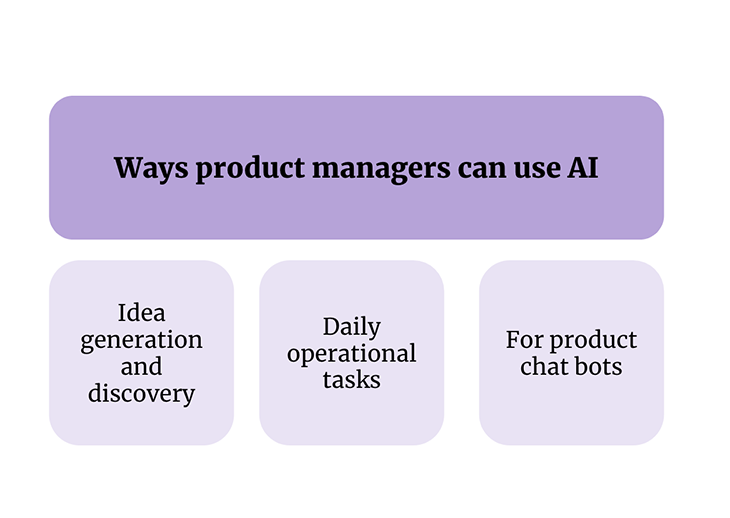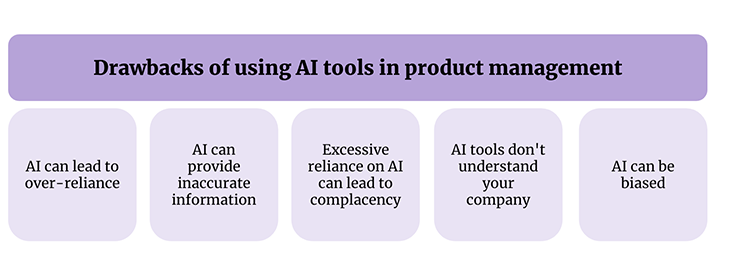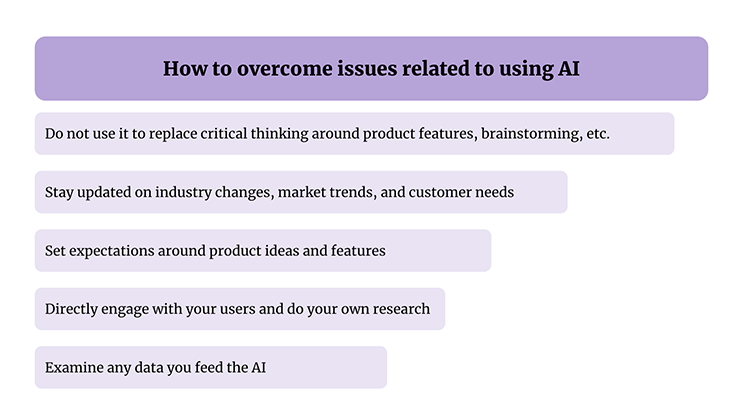AI is being increasingly used in every field within product management to facilitate our daily tasks, development processes, and improve UX. This sounds like a jackpot if AI can do all of this, isn’t it? However, is this the only side we see? Does AI only bring benefits for product teams?

In this article, we’ll talk about the drawbacks using AI in your product management workflow and how to overcome them.
For you to know what AI lacks in product management, you first must know how we use it currently and the advantages it brings to us. AI tools can be used to facilitate a very large amount of tasks, such as generating ideas — especially in the ideation and discovery phases.
It is also frequently used in chatbots to answer product-related questions and guide users before connecting them to an online agent.
Other than this, AI can be used by product managers for a bunch of other small day-to-day operational tasks, such as efficiently drafting emails or even translating texts:

To sum it all up, product managers can use AI to simplify their tasks or to focus on what is more important in the product development process. However, using AI becomes meaningless and even risky for the company if not used correctly. So what are the drawbacks of using AI in product management?
Technology is advancing rapidly, reaching levels of intelligence we wouldn’t have thought possible just a few years ago. However, since AI is a human creation, it has its limitations.
Nowadays, AI is incredibly efficient — so much so that members of product management teams might believe they can wholly depend on it for their work. However, this is a misconception, for the reasons I’ll discuss below:

One of the key drawbacks of using AI is that it can encourage many product managers to become overly dependent on it, a mistake that is frequently made.
AI’s impressive capabilities — its time-saving features and efficiency — can make it all too easy to want to use it for virtually every aspect of the job. This is a trap that many product managers unwittingly fall into.
While AI can undoubtedly enhance a product manager’s role, it should not replace human judgment and critical thinking. No matter how advanced AI tools become, they lack the human touch essential to product management — the ability to understand complex human emotions, to read between the lines, and to build products that evolve with the changing social trends and ideas.
Have you ever asked a tool like ChatGPT a question, only to find that it provided a completely wrong answer?
Over the last three months, I’ve conducted numerous trials by asking ChatGPT complex questions on various subjects. Whenever it didn’t know how to answer a question, it often provided an unclear response filled with incorrect information. Over these three months, ChatGPT has only a few times admitted that it lacks the knowledge to answer my queries.
Moreover, there have been multiple instances when I’ve asked ChatGPT something and then doubted the validity of its response. The AI then apologizes for the confusion and provides a different response right away. However, what’s surprising is that the first response was correct, and the second one was incorrect.
AI tools are designed to assist humans in completing tasks more efficiently, not to replace human labor completely. This means product managers should utilize AI tools but verify the results with their own judgment. To do this effectively, it’s crucial to continuously expand our knowledge in our respective fields and stay updated on industry changes, market trends, and customer needs.
When you use an AI tool like ChatGPT, understanding the context and the subject matter will allow you to decide whether the AI’s output makes sense and if it provided the correct answer. Having deep expertise in your field can also enable you to provide the necessary context to the AI, ensuring its effective use within your specific product management needs.
As AI tools become more sophisticated, there’s a risk that people might become overly reliant on them. If AI usage becomes pervasive in product management, the team may become less innovative and even lazy.
I’ve noticed that more and more product team members are quick to say, “I’ll ask ChatGPT,” for questions that would take less than three minutes to answer with a bit of thinking. My fear is that this reliance on AI for every question could lead the team to stop using their critical thinking skills and solely depend on AI, losing their innovative edge in the process.
AI follows predefined steps and methodologies and lacks the capacity for innovation and understanding specific or unique issues. For example, I asked an AI tool to provide a list of features for a travel mobile app I planned to launch. The AI provided a comprehensive list, but when I used different accounts to ask for features of a budget travel app, the AI offered almost the exact same list for both queries across three different accounts.
The takeaway here is that if you’re using AI to determine the features of your product, there’s a good chance your competitors are doing the same. Consequently, relying on AI for such critical decisions could result in your product looking very similar to hundreds of others in the market, offering no unique selling proposition or added value. This lack of differentiation makes it more challenging for potential clients to choose your product over others.
Product management often requires thinking outside the box, exploring new possibilities which may not align well with the limitations of AI tools. Of course, you can’t ban the team from using AI tools because it may make them lazy or lack innovation. But as a team leader, you can manage how the product team members use AI.
Raise awareness about this within the team and set expectations about the product ideas. Make it clear that mainstream ideas you can find everywhere are not welcome. You should create environments that promote collaboration. Organize many brainstorming meetings, and encourage everyone to think broadly.
This way, you will notice that novel ideas that can’t be given by AI will flow.
When it comes to addressing specific issues related to your product, AI tools may not be the most appropriate choice. They are limited in comprehending the unique context of your product situation since they rely solely on patterns and data. AI tools cannot grasp your company’s goals, vision, history, past decisions, variables, resources, and so forth.
One crucial point is that AI tools cannot understand your customers the way humans can, because unlike humans, AI lacks emotional intelligence. In product management, understanding clients’ emotions is critical because it helps in developing products that resonate with customers and facilitates customer-centric decisions.
AI often provides generic or inaccurate responses because their knowledge is “frozen” or static. The machine learning algorithms powering AI-based solutions heavily depend on the data fed into them.
The best approach to this issue is not to overly rely on AI. Instead, directly engage with users, conduct user research, and gather qualitative feedback to understand emotional aspects, user sentiments, and preferences that AI cannot comprehend in the same way as humans do.
If you plan to delegate more decision-making to AI or rely entirely on it, you need to understand that AI can exhibit bias. AI learns from humans, and our world is inherently biased. Consequently, AI tools can inadvertently mirror these human biases based on the data input and learning processes.
To illustrate AI bias, consider the incident with Apple’s credit card in 2019. It was reported that the card’s credit limit algorithm seemed to offer lower credit limits to women compared to men with similar financial backgrounds. This bias became apparent when David Heinemeier Hansson revealed on Twitter that his wife was offered a credit limit 20 times less than his, despite similar financial situations.
AI can indeed be prejudiced and may lead your team to make biased decisions if not carefully monitored.
In the current era, humans and technology complement each other; neither can accomplish significant feats alone. When AI tools face challenges beyond their capabilities, human intervention is necessary.
As a product manager, the first step is to examine the data used to train your algorithms to ensure decision-making does not replicate existing societal biases. For instance, if the data input to the AI relates to a specific user group (like a particular gender), do not use the same data input for a different user category not represented in the dataset. If you do, you may get biased results and make biased decisions.
Furthermore, continuously providing feedback to the AI system can improve its performance over time by allowing it to learn from each interaction. This iterative process helps in gradually reducing the system’s biases.
By keeping all of these practices in mind, you can make intentional decisions around your workflows and avoid the far-too-common drawbacks of using AI tools:

In order to avoid errors while utilizing AI tools and maximize their benefits in product management, it’s crucial to be aware of the potential drawbacks and find ways to enhance AI’s capabilities with your human expertise.
Always rigorously examine the ideas generated by AI tools. Remember that they can be tailored to suit your needs. However, never lose sight of the fact that product management revolves around understanding customers’ needs and developing solutions for humans. If we delegate all work to AI, the solutions we produce may lack the vital human touch that makes products resonate with users.
Featured image source: IconScout
LogRocket identifies friction points in the user experience so you can make informed decisions about product and design changes that must happen to hit your goals.
With LogRocket, you can understand the scope of the issues affecting your product and prioritize the changes that need to be made. LogRocket simplifies workflows by allowing Engineering, Product, UX, and Design teams to work from the same data as you, eliminating any confusion about what needs to be done.
Get your teams on the same page — try LogRocket today.

Great product managers spot change early. Discover how to pivot your product strategy before it’s too late.

Thach Nguyen, Senior Director of Product Management — STEPS at Stewart Title, emphasizes candid moments and human error in the age of AI.

Guard your focus, not just your time. Learn tactics to protect attention, cut noise, and do deep work that actually moves the roadmap.

Rumana Hafesjee talks about the evolving role of the product executive in today’s “great hesitation,” explores reinventing yourself as a leader, the benefits of fractional leadership, and more.